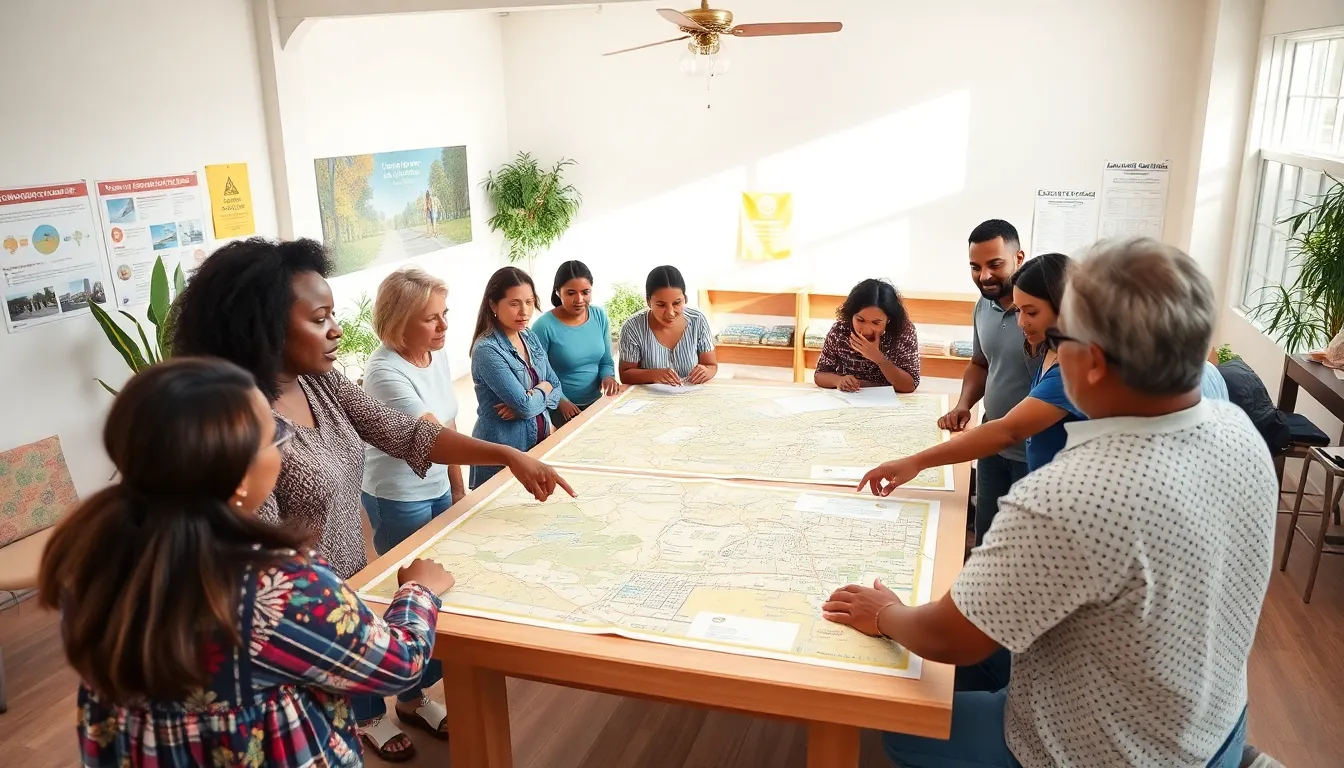In the grand game of province development planning, it’s not just about maps and budgets; it’s about crafting a vision that turns dreams into reality. Imagine a world where every community thrives, where roads don’t just lead to dead ends, and where parks aren’t just patches of grass but vibrant hubs of activity. Sounds like a fairy tale? It doesn’t have to be.
With the right planning, provinces can transform into flourishing landscapes filled with opportunity. It’s all about prioritizing needs, engaging communities, and ensuring that every decision counts. So grab your hard hat and a cup of coffee—it’s time to dig into the nitty-gritty of making provincial dreams come true. After all, who wouldn’t want to be part of a plan that could turn their province into the next big thing?
Table of Contents
ToggleOverview of Province Development Planning
Province development planning involves strategic approaches to foster economic, social, and environmental sustainability. This process requires identifying goals that align with community priorities, ensuring resources are allocated effectively. Stakeholders play a critical role; local governments, community organizations, and residents contribute valuable insights that shape development initiatives.
Effective planning includes analyzing demographic trends, infrastructure needs, and economic opportunities, which provide a clear roadmap for growth. Data-driven assessments lead to informed decisions that address immediate community requirements while considering long-term impacts. By leveraging these insights, planners can create programs that enhance public services, promote education, and create jobs.
Engaging communities in the planning process promotes collective ownership of initiatives. Participatory methods, such as workshops and surveys, enable community voices to influence plans actively. Planners must prioritize transparency and communication to build trust and encourage stakeholder involvement.
Sustainable practices represent another vital aspect of province development planning. Incorporating green spaces, improving public transport, and investing in renewable energy not only enhance residents’ quality of life but also protect natural resources. Prioritization of these practices contributes to creating resilient and adaptive communities that can respond to changing conditions.
Ultimately, successful province development planning leads to comprehensive strategies that revitalize regions, making them desirable places to live and work. By addressing diverse needs through collaborative efforts, provinces can emerge as vibrant hubs that foster innovation and opportunities. Emphasizing progressive planning cultivates an environment where both individuals and businesses can thrive.
Importance of Province Development Planning

Province development planning holds significant value, guiding regions toward sustainable growth and progress. This process cultivates interconnected communities focused on collective well-being.
Economic Growth
Economic growth hinges on a strategic framework that maximizes resources and opportunities. Sustainable development attracts investment, enhancing job creation and boosting local economies. Roadmaps detailing infrastructure needs play a vital role in guiding economic initiatives. By analyzing demographic trends, planners can identify market demands and growth areas. Collaborative partnerships with local businesses foster an environment conducive to entrepreneurship. Engaged stakeholders share insights, leading to targeted actions that generate positive economic outcomes. Realizing tangible benefits takes priority when communities align goals with economic strategies.
Social Development
Social development reinforces the fabric of communities, prioritizing inclusivity and quality of life. Engaging local residents in the planning process cultivates a sense of ownership and pride. Investment in education, healthcare, and social services ensures accessibility for all, addressing systemic disparities. Building green spaces and recreational facilities promotes mental and physical well-being. Empowering marginalized groups fosters diverse perspectives and enhances community resilience. Collaborative efforts among stakeholders enhance overall social cohesion, driving collective growth. Prioritizing social needs ensures that development outcomes positively impact community dynamics.
Key Components of Effective Planning
Effective province development planning relies on key components that ensure sustainable growth. Prioritizing stakeholder engagement and rigorous data analysis plays a critical role in shaping successful initiatives.
Stakeholder Engagement
Involving stakeholders fosters collaboration and enhances project ownership. Local governments, community organizations, and residents should participate actively in the planning process. Engaging with diverse perspectives leads to solutions that reflect community needs. Transparent communication helps build trust and encourages input from all sectors. Regular meetings and workshops provide opportunities for dialogue. Feedback mechanisms allow residents to voice their concerns, leading to informed decision-making. Ultimately, inclusive participation strengthens connections within communities, creating a foundation for successful implementation.
Data Analysis and Research
Data analysis and research form the backbone of effective planning. Gathering demographic trends, infrastructure needs, and economic indicators informs strategic decisions. Reliable data enables planners to identify growth opportunities and address challenges proactively. Utilizing geographic information systems enhances visualization of data, aiding in identifying regional needs. Regular updates to data ensure that plans reflect current realities. Reports and studies provide insights into best practices used in other provinces. Well-informed strategies align resources with community priorities, driving sustainable development forward.
Challenges in Province Development Planning
Province development planning faces significant challenges that hinder progress. Notably, effective resource allocation presents a complex dilemma for planners.
Resource Allocation
Budgets often appear limited, forcing planners to prioritize projects with immediate impact. Competing demands from various sectors, including education, infrastructure, and social services, complicate decision-making. Stakeholders may experience frustration when their needs clash with those of others. An efficient allocation framework helps clarify priorities based on community needs. Prioritizing projects that enhance economic growth ensures that limited resources contribute to long-term benefits. Data-driven assessments frequently highlight areas needing urgent attention, guiding planners in resource distribution.
Political Factors
Political dynamics significantly influence province development planning efforts. Leaders’ commitments to development policies can shift with changes in administration. Diverse interests among political parties may create conflicts that delay planning processes. Stakeholder engagement often becomes essential for navigating this complex political landscape. Effective communication with local governments fosters collaboration and understanding among parties involved. Legislative frameworks may also impose restrictions, limiting the scope of development initiatives. Understanding these political factors helps planners devise strategies that align with shifting priorities while fostering a collaborative approach to development.
Best Practices in Province Development Planning
Effective province development planning requires informed strategies. Best practices emerge from real-world examples and innovative techniques.
Case Studies
Successful province development planning case studies showcase diverse approaches. For instance, a province in Canada improved economic growth through sustainable tourism initiatives. Local stakeholders collaborated to promote heritage sites, which increased visitor numbers by 30%. Similarly, another case in Australia emphasized community involvement, leading to the creation of several green spaces. Engagement with residents fostered a sense of ownership and pride, resulting in a 40% boost in community participation for local events. By analyzing these examples, planners identify strategies that resonate with community needs.
Innovative Approaches
Innovative approaches enhance the effectiveness of province development planning. Utilizing technology like Geographic Information Systems allows planners to visualize data accurately. It streamlines decision-making processes, ultimately promoting better resource allocation. Additionally, adopting a multi-disciplinary framework can lead to integrated strategies across sectors. For example, programs that blend urban planning with environmental efforts create sustainable solutions that cater to diverse community needs. Collaborative platforms also facilitate information sharing, enabling stakeholders to collectively address challenges while developing adaptive solutions. Embracing these innovative practices inspires inclusive growth within communities.
Effective province development planning is vital for fostering sustainable growth and enhancing community well-being. By prioritizing collaboration among stakeholders and engaging residents, regions can create inclusive environments that reflect collective goals. This approach not only addresses immediate needs but also lays the groundwork for long-term prosperity.
Investing in education, healthcare, and green spaces strengthens community dynamics and promotes resilience. As provinces navigate challenges like resource allocation and political shifts, a strategic framework ensures that development remains focused on maximizing opportunities. With innovative practices and data-driven insights, provinces can transform their landscapes into thriving hubs where individuals and businesses flourish.



